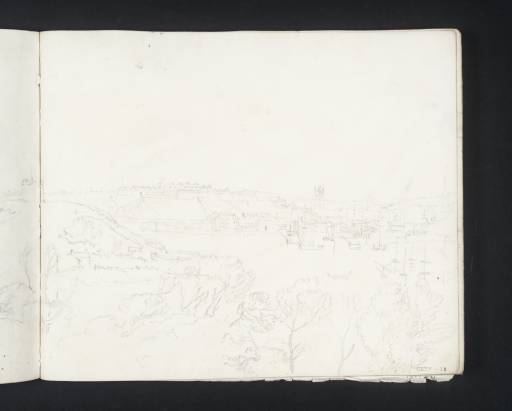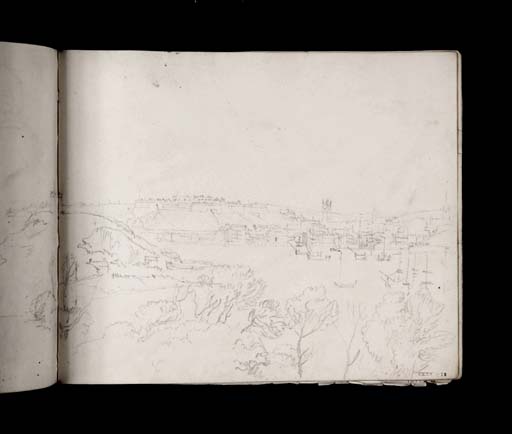Joseph Mallord William Turner Plymouth: The Citadel, St Andrew's Church and the Charles Church from Mount Batten 1811
Image 1 of 2
Joseph Mallord William Turner,
Plymouth: The Citadel, St Andrew's Church and the Charles Church from Mount Batten
1811
Joseph Mallord William Turner 1775–1851
Folio 13 Recto:
Plymouth: The Citadel, St Andrew’s Church and the Charles Church from Mount Batten 1811
D08879
Turner Bequest CXXV 12
Turner Bequest CXXV 12
Pencil on white wove paper, 166 x 208 mm
Blind-stamped with Turner Bequest monogram bottom right
Stamped in black ‘CXXV – 12’ bottom right
Blind-stamped with Turner Bequest monogram bottom right
Stamped in black ‘CXXV – 12’ bottom right
Accepted by the nation as part of the Turner Bequest 1856
References
1909
A.J. Finberg, A Complete Inventory of the Drawings of the Turner Bequest, London 1909, vol.I, p.355, CXXV 12, as ‘Plymouth, with Mount Batten, from Turn Chapel, Looking over Catwater’.
1979
Andrew Wilton, J.M.W. Turner: His Life and Work, Fribourg 1979, p.352 under no.457.
1981
Eric Shanes, Turner’s Rivers, Harbours and Coasts, London 1981, p.152.
1997
Eric Shanes, Turner’s Watercolour Explorations 1810–1842, exhibition catalogue, Tate Gallery, London 1997, p.91 note 2 under no.27.
The composition spans the whole of this page, extending left to the first third of folio 12 verso opposite (D08878; CXXV 11a), with a narrow continuation to the right on folio 14 recto (D08880; CXXV 13). The overall view of the tower at Mount Batten with Plymouth’s Citadel, the tower of St Andrew’s Church and the spire of the Charles Church can still be seen (albeit interspersed with tower blocks) from Lawrence Road, west of Turnchapel, overlooking the harbour at Clovelly Bay and the Cattewater.
Finberg notes that the triple-page sketch is the basis of the watercolour Plymouth, with Mount Batten of about 1816 (Victoria and Albert Museum, London),1 engraved in 1817 for the Picturesque Views on the Southern Coast of England2 (see the concordance of the series in the 1811 tour introduction). In fact, the right-hand continuation was not incorporated into the finished composition. Eric Shanes has noted that the sketch also informs the watercolour Plymouth of about 1825 (Museu Calouste Gulbenkian, Lisbon),3 engraved in 1828 for the The Rivers of England, but not published until 1856 in The Harbours of England.4 There the wooded foreground is omitted and the scene is effectively viewed from the beach recorded in the middle distance of the sketch.
Verso:
Blank
Matthew Imms
February 2011
How to cite
Matthew Imms, ‘Plymouth: The Citadel, St Andrew’s Church and the Charles Church from Mount Batten 1811 by Joseph Mallord William Turner’, catalogue entry, February 2011, in David Blayney Brown (ed.), J.M.W. Turner: Sketchbooks, Drawings and Watercolours, Tate Research Publication, December 2012, https://www


